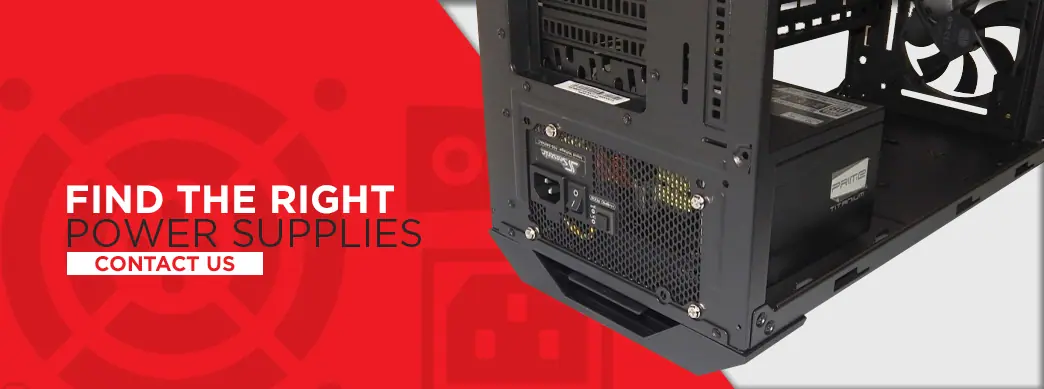
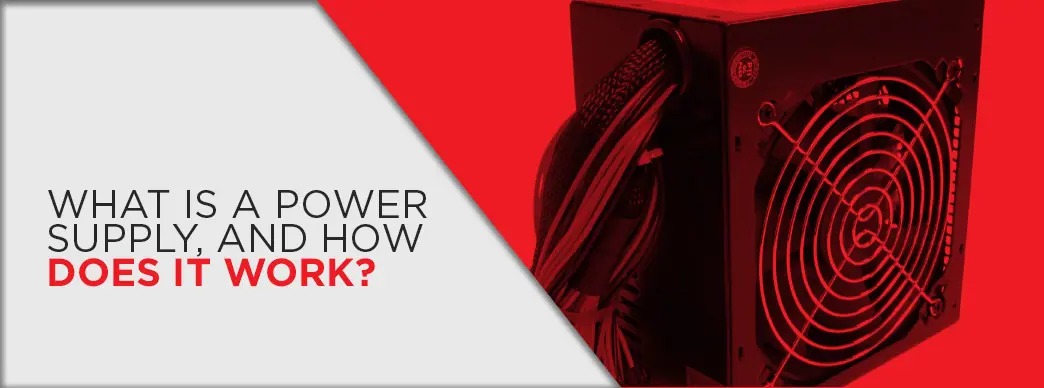
Quick Navigation:
Power supplies appear everywhere, and knowing how they work will help you select the best application options. Whether you need high-voltage power on board a ship or need to plug in a notebook computer to charge, you need a power supply. Because not all models are the same, you need to know what makes an ac-dc power supply unique, how to choose the best supplies for your electrical devices, and much more. If you’ve ever had questions about how a power supply works, its definition, or what it does, discover the answers here.
Do not confuse a power supply with a power source. The source is the origin of incoming electricity. The electricity source is usually an outlet, battery, or generator. The power supply converts the power from the source into the correct format and voltage. Because various options exist, the specific power supply function depends on whether it needs to regulate energy or convert power. To understand a power supply and its workings, you must know its parts and their contributions to the device’s operation, as discussed below.
Power supplies have essential functions found in all models with additional operations added depending on the device type. Power supplies may need to change voltage up or down, convert power to direct current, or regulate power for smoother outgoing voltage. These functions will help you choose which supply you need for your electrical needs. Getting a device with too many features could cost you more money than you need, but if you don’t get the features you require, you could damage the devices you need to power.
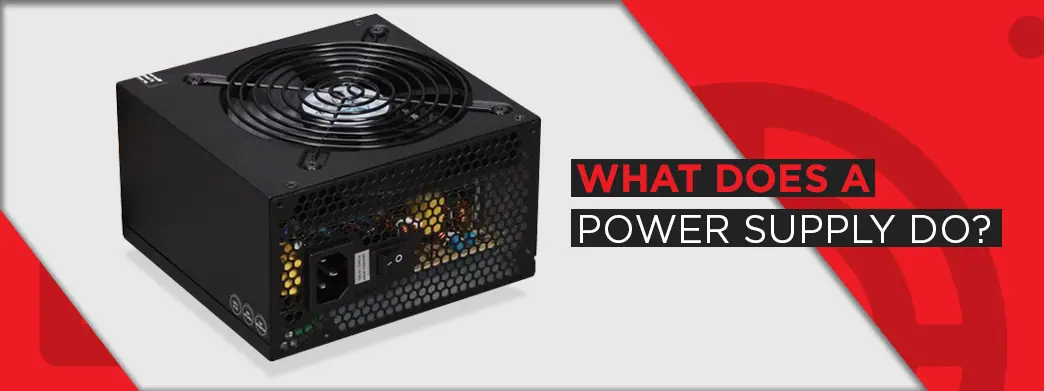
Power supplies are primarily used for changing voltage. The power source has a steady output, regardless of the device that must be used. To prevent overload, power supplies step down the voltage—or, conversely, step it up—to match the device’s requirements.
Too much power from a power supply can severely damage a device, but if it does not deliver enough voltage, the device will not operate as it should. Energy changing is the main task of power supplies, and the bulk of their construction comes from the transformer used to move the voltage up or down as needed.
Power conversion converts the incoming electricity to a format that the electrical device can use. Two types of power supplies exist: DC-DC and AC-DC. DC-DC power supplies allow you to plug electrical devices into car outlets or similar sources that supply direct current, or DC, power. These power supplies are not the most commonly used, though.
Most electronics require regulated power. When a power supply changes the voltage and type of power, the result is not always a steady output. Though it does not turn on and off completely, fluctuations in the outcoming voltage still occur without regulation. An unregulated power supply can deliver more power than expected. Such a surge fed to delicate electronics like computers and televisions could cause severe damage to the parts or even permanent harm that could cause damage beyond repair.
The added function of regulating power increases the cost of the device. Still, it can save you the price of purchasing new electronics to replace those ruined by unregulated voltage overwhelming them. To save money while powering devices with loads that closely match the power supply’s output, use unregulated power supplies. But electronics require regulated power. Don’t make the mistake of selecting the wrong supply.
Basic power supplies will change the voltage and convert to DC power. These standard operations send unregulated voltage out of the power supply. Still, if you need regulated power, the devices have another step of regulating the voltage to smooth out waves. To discover more about how a PSU (power supply unit) works, read on to learn about the individual parts and their functions, which will clarify your view of the entire operation of the power unit.
Basic power supplies consist of several parts. These components help the unit to step up or down voltage, convert power, and reduce ripple voltages, which are residual variations in the voltage and result in wasted power and overheating.
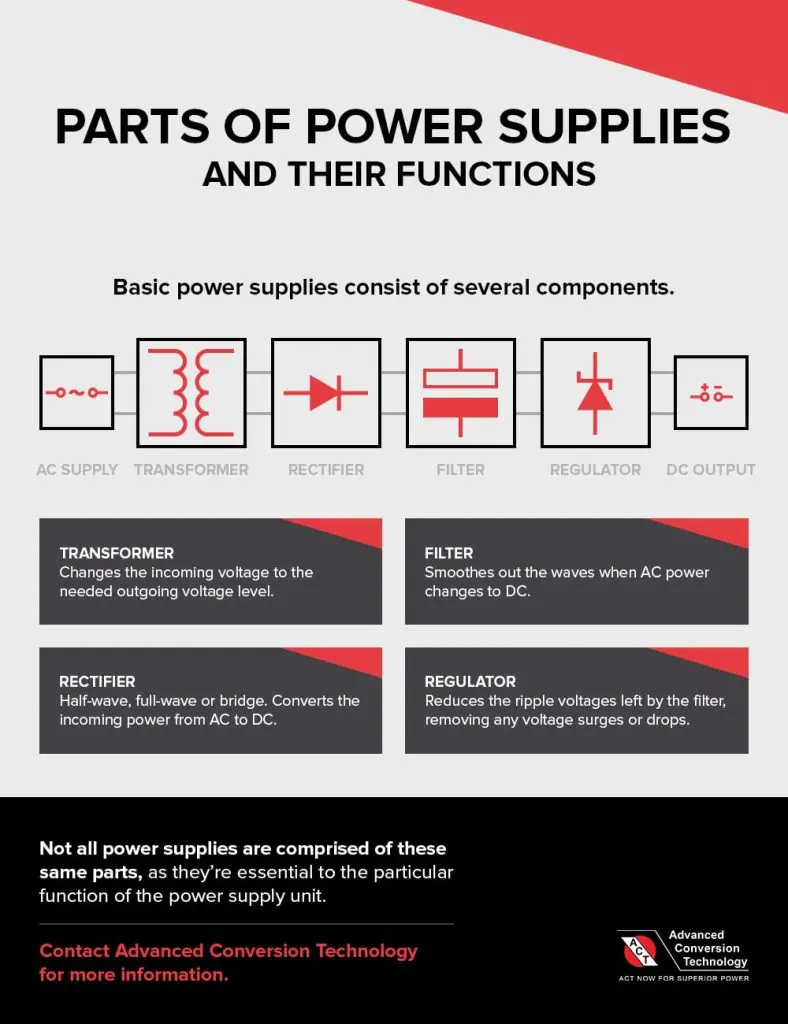
Power supply components are essential to the particular function of the power supply unit. As a result, not all power supplies will consist of the same parts.
The power supply transformer raises or lowers the voltage as needed. Most devices require stepped down voltage from standard AC outlets, which output 100 to 240 volts, to a much lower amount. Some transformers, however, will step up the voltage and isolate the incoming and outgoing circuits.
Incoming power enters the transformer through the primary winding, and outgoing electricity connects to the secondary winding. These two windings have no physical connection, which ensures the safety of the transformer. Faraday’s Law allows electromagnetic energy to be induced on the secondary winding from the primary winding without the need for contact between these parts.
Once finished stepping up or down the voltage, the transformer sends the outgoing power to a rectifier to convert the alternating current into direct current.
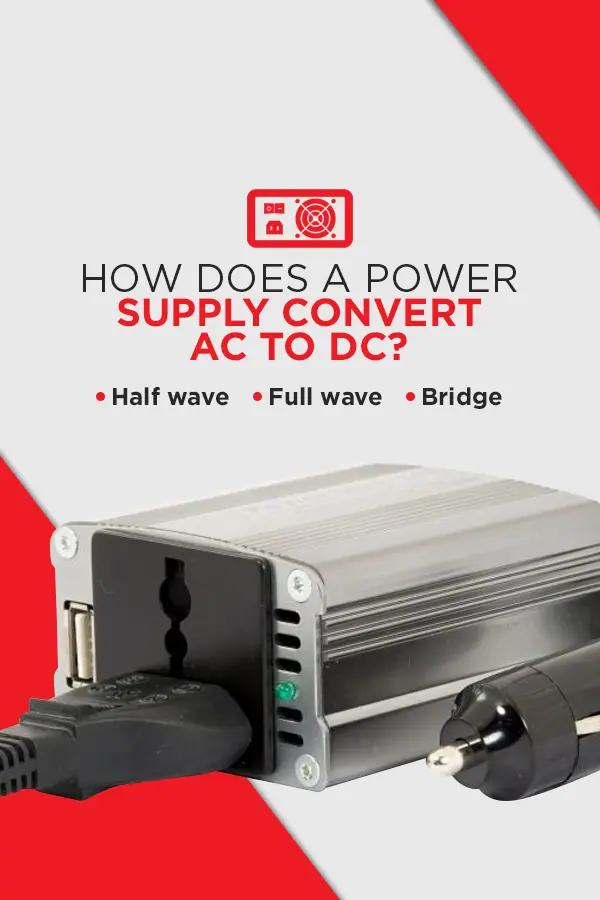
Part of how an AC-to-DC power supply works is the rectifier in the unit that changes the current type. Power supply creators choose from three types of silicon diode rectifiers to convert AC power to DC. Each model has its operation and benefits.
After conversion, most DC power will still have output ripple. A capacitor directly filters out the worst of the ripple as the electricity leaves the rectifier.
Capacitors hold electrons until needed. As the current passes through the capacitor, it moves in waves. The peaks already have enough electrons, but the troughs represent lower amounts of electricity that correspond to lower levels of electrons. As the current waves drop, the need for extra electrons increases. The capacitor feeds electrons into the current, making the waves smoother. Smoother waves provide more even electricity without ebbs and surges.
While capacitors do not create utterly smooth power, they do reduce the highs and lows that leave a rectifier. If you need a consistent flow of electricity, you must have a regulated power supply. These devices fill in the remaining troughs left after the current leaves the capacitor. Power supplies that connect to electronics require regulators to protect the delicate circuitry of such devices.
After the current leaves the filter, the power supply’s task ends in an unregulated model. While unregulated power supplies suffice for general use, when you need entirely stable electricity that does not change when the load does, you need regulated power. Regulated power supplies come in two forms based on how they regulate energy — linear and switching.
A linear power supply uses a simple, straightforward operation method to convert electricity and nearly eliminate ripple voltage. The design starts with a transformer to reduce the voltage. The device then converts AC to DC power. Then, the DC power goes through a regulator that cleans it by reducing the ripple voltage.
This regulated power supply option weighs more because the large transformer must step down the power. Fortunately, linear power supplies have a low-noise operation, making them a better choice when you need low power and a clean, consistent supply. Medical settings, laboratories, and communications facilities benefit most from this type of regulated power supply.
Switching power supplies are more efficient, have higher capacities, and are smaller than their linear counterparts. However, these models generate noise during use, especially when switching power. Switching power supplies are more versatile than linear power supplies, which are best for specific applications. These devices’ flexibility is due to their use of pulse width modulation (PWM).
PWM makes switching power supplies much more efficient than linear ones and allows them to change to different electricity sources quickly. Select switching regulating power supplies when you require higher power output and more efficiency in a smaller size than you can get from a linear regulated power supply.
Power supplies tend to be the most prone to failure when used for personal computers due to their frequent temperature fluctuations and intense use. Of course, electronics such as computers and televisions require power supplies and require replacement more often than other components. However, these are not the only uses of power supplies.
Power supplies do more than provide electricity for electronics. These devices may be internal or external and provide energy to appliances, lights, and more. If you have a part that requires electricity, you probably have a power supply in or connected to that device.
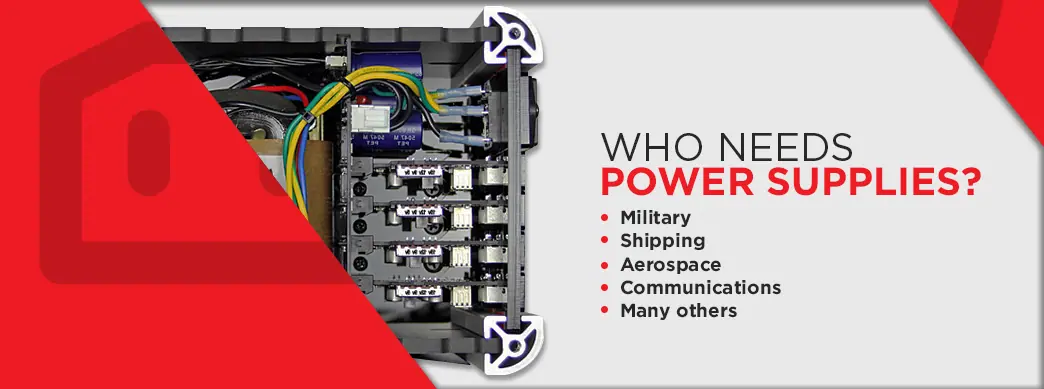
Anyone who uses electricity needs power supplies. The types of supplies will depend on whether you need AC-DC or DC-DC converters or if you require regulated or unregulated power. High or low voltage is another choice you will need to make. If you need weather- or impact-resistant power supplies, you will also need to add that to the list of requirements.
Learn About Power Supply Applications
Several industries use power supplies daily. Listed here are just some of the industries that can make use of the variety of military-grade power supplies ACT has to offer.
The question is not whether you need a power supply but what type your situation requires. That’s where we at Advanced Conversion Technology (ACT) can help you.
You can find the power supplies you need at ACT if you need AC-DC or DC-DC converters for high or low voltage. Because we cater to a wide variety of applications that have innumerable requirements for power supply specifics, we likely have the right products for your use. However, some of those with whom we work cannot find what they need from our listings. Luckily, we have the resources available to create custom power supplies tailored to their needs. Contact us via our form or request a product if you need a customized solution. We’re available to help you with whatever your power needs, from simple to complex.
